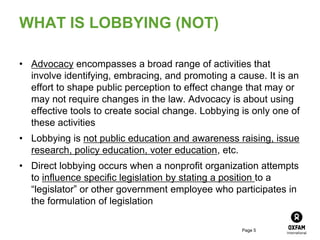Lobbying: The art of the possible
- 1. Lobbying: the art of the possible VOICES Pooven Moodley November 2012
- 2. WHAT IS LOBBYING Page 2
- 3. WHAT IS LOBBYING Page 3
- 4. WHAT IS LOBBYING ŌĆó Lobbying means engaging directly with decision-makers and persuading them to take up your cause or change their position on an issue. ŌĆó Lobbying is an art, not a science, and every successful lobbyist must develop a range of skills and an individual style which may vary according to circumstance. ŌĆó Getting access to the right people, writing effective letters and e-mails, making an all important telephone call or building good relationships with the lobby targets are all essential skills that the successful lobbyist needs to develop. ŌĆó However, nothing beats personal face-to-face engagement with key decision-makers in terms of getting your message across. Page 4
- 5. WHAT IS LOBBYING (NOT) ŌĆó Advocacy encompasses a broad range of activities that involve identifying, embracing, and promoting a cause. It is an effort to shape public perception to effect change that may or may not require changes in the law. Advocacy is about using effective tools to create social change. Lobbying is only one of these activities ŌĆó Lobbying is not public education and awareness raising, issue research, policy education, voter education, etc. ŌĆó Direct lobbying occurs when a nonprofit organization attempts to influence specific legislation by stating a position to a ŌĆ£legislatorŌĆØ or other government employee who participates in the formulation of legislation Page 5
- 6. LEVEL ŌĆó Influence decision makers to change public policies and practices in ways that will have a positive impact on poor peopleŌĆÖs lives. It might involve lobbying for new policies and practices, or reforming, enforcing or eliminating existing ones. ŌĆó Lobbying can take place at any level with any decision maker from a community leader to a President or global institutions like the UN and G20 ŌĆó The term ŌĆ£lobbyingŌĆØ carries negative connotations in some contexts like the USA as it is often associated with scandals involving paid lobbyists representing corporate interests. ŌĆó Lobbying by nonprofit organizations is a legal and acceptable activity that is often essential to creating good public policy and stronger, more democratic communities Page 6
- 7. BACK IN TIME ŌĆó USA ŌĆó South Africa: Examples from the early days of democracy ŌĆó Africa: Examples from the continent including AU Finance Minister, Pan Africa Parliament, BUSAN Page 7
- 8. TIPS: FACE TO FACE MEETINGS ŌĆó Never mistake access for influence. ŌĆó Confirm the timing and agree the agenda in advance, ideally in writing ŌĆó Be absolutely clear about your objectives and your key asks ŌĆó Know who will be with the person you are meeting (civil servants, advisers, etc). If possible, have an informal chat with them in advance ŌĆó Make sure they know who is accompanying you and security have been given names ŌĆó Think about numbers ŌĆō the more people, the more formal and often less useful Page 8
- 9. TIPS:FACE TO FACE MEETINGS ŌĆó Ensure mix of skills and expertise, gender balance, diversity and seniority of delegation ŌĆó Have a pre-meeting with colleagues in advance to allocate roles and responsibilities, including who is responsible for taking along and handing over any relevant materials ŌĆó Never be late and allow enough time for security clearance where necessary (Mandela) ŌĆó Think about dress-code ŌĆō sitting in a meeting where you are inappropriately dressed will make you feel uncomfortable, and might mean youŌĆÖre not taken so seriously Page 9
- 10. TIPS: FACE TO FACE MEETINGS ŌĆó Agree who will lead the meeting and keep to time. Thank the decision-maker for his/her time, do introductions and re-cap on your agenda ŌĆó Have a note-taker if possible. Agree meeting terms in advance: on or off record, confidential ŌĆó Know your stuff but donŌĆÖt be over-rehearsed, itŌĆÖs meant to be a dialogue, not a monologue. Listen and respond to what the decision-maker says, give him/her sufficient time to speak ŌĆó Show respect for other sideŌĆÖs point of view. Try to build on common ground in the discussion Page 10
- 11. TIPS: FACE TO FACE MEETINGS ŌĆó Ensure someone is responsible for summing up and agreeing next steps, and that they intervene to do this once the meeting is drawing to a close ŌĆó After the meeting, have a de-briefing with your delegation ŌĆó Follow with a letter thanking him/her for meeting and noting agreement and next steps ŌĆó Make sure that you follow-up on anything you agree to do, like sending further information Page 11










